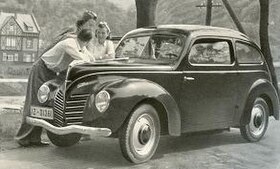Ford Taunus G93A
| Ford Taunus G93A (1939–1942) Ford Taunus G73A (1948–1952) |
|
|---|---|
 |
|
| Overview | |
| Manufacturer | Ford Germany |
| Also called | "Buckeltaunus" |
| Production | G93A: 1939–1942 G73A: 1948–1952 |
| Assembly | Cologne-Niehl, Germany |
| Body and chassis | |
| Class | Small family car (C) |
| Body style | 2-door saloon a wide range of coach-built bodies, including cabriolets and station wagons became available after 1949 |
| Powertrain | |
| Engine | 1172 cc Ford Sidevalve engine 4-cylinder in-line water-cooled |
| Transmission | 3-speed manual with synchromesh on upper two ratios. 4-speed manual offered on some models after 1950 |
| Dimensions | |
| Wheelbase | 2,387 mm (94.0 in) |
| Length | 4,080 mm (160.6 in) |
| Width | 1,485 mm (58.5 in) |
| Height | 1,600 mm (63.0 in) |
| Curb weight | 840–1,040 kg (1,852–2,293 lb) |
| Chronology | |
| Predecessor | Ford Eifel |
| Successor | Ford Taunus P1 |
The Ford Taunus G93A is a small family car that was produced by Ford Germany between 1939 and 1942 in succession to the Ford Eifel. It was the first car developed at Cologne by Ford Germany which previously had built cars originated by Ford businesses in the US or the UK. Production began on 30 April 1939, with the first car exhibited to the public in June 1939, less than six months before the outbreak of war in Europe.
In 1948 the car reappeared as the Ford Taunus G73A, and remained in production until 1952. This was the first (and until the 1970s the last) Ford Taunus to feature a fastback shape: in this application the rather severe slopes enforced by squeezing North-American style fast-back styling onto a relatively short wheelbase was not universally admired: the car became known as the "Buckeltaunus" (Hunchback Taunus).
On 30 April 1939 Ford Cologne began to manufacture the Taunus, a mid-size car intended to slot into the range between the little Ford Eifel and the company’s big V8 models. The car was presented to the public in June 1939. Although the structure of the car did not follow the revolutionary monocoque structure heralded by the Opel Olympia, the Taunus did have its body welded to the chassis rather than having the two elements simply bolted together. The advertised price at launch was 2870 Marks, but customers had the option of paying an extra 22 Marks for a shatterproof windscreen.
Stylistically the new car followed the 1930s fashion for streamlining, but with a North American flavour inspired by the Lincoln-Zephyr of the time. The bodyshell was supplied from the Berlin plant of pressed steel experts, Ambi Budd. Like the Eifel, the Ford Taunus came with rigid axles, but with the innovation of hydraulic brakes.
The Taunus was designed to take a 45 PS (33 kW; 44 hp) 1.5-litre side-valve engine developed from the 1.2-litre unit used in the Eifel. However, in March 1939 the government, anticipating war, introduced restrictions whereby Ford were permitted to produce only a single standardised engine in the class of cars covered by engine sizes between 1.2 and 2.0 litres, and so the Taunus used the smaller 1,172 cc engine, carried over from the Eifel model. This was essentially the same unit that Ford would fit in the Ford Taunus P1 (and, at their Dagenham plant the Ford Anglia) until 1959.
...
Wikipedia
